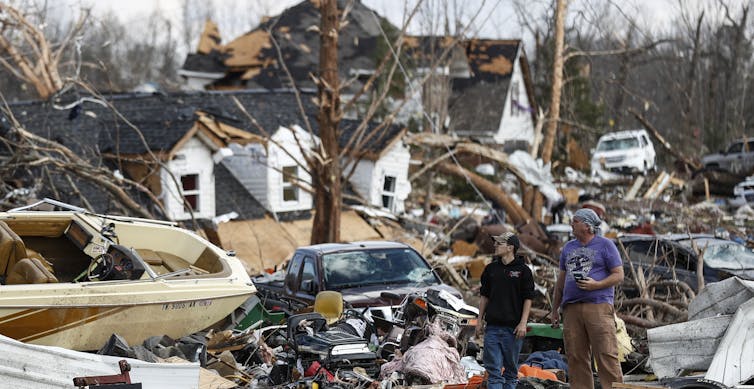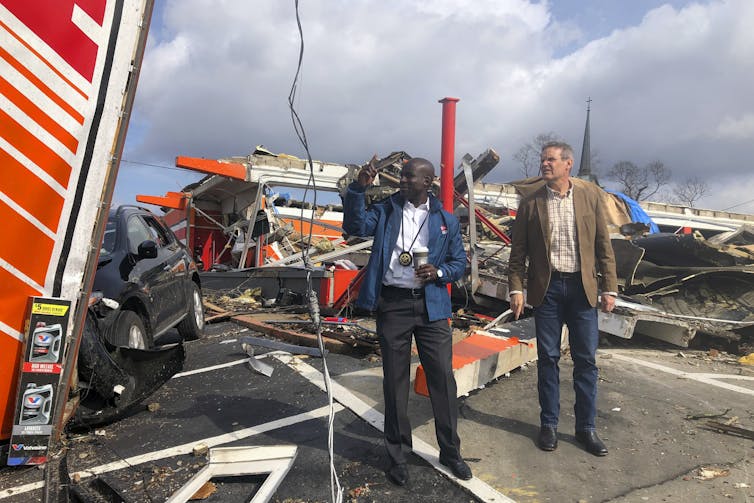Nashville Tornadoes: Why Give Cash?

The wreckage in Nashville was extreme. AP Photo/Wade Payne
Julia Brooks, New York University
If you want to help after the Nashville tornadoes, give cashMoney in physical form such as banknotes and coins. More, not clothing and other stuff
Powerful storms and tornadoes left a trail of devastation as they ripped through Nashville on March 3, killing 25 people, injuring dozens more and leaving hundreds homeless. As first responders and residents of the Tennessee city searched for the missing, assessed the damage and began to pick up the pieces, relief efforts started taking shape right away.
In the aftermath of such tragedies, the urge to help is laudable. Some organizations and community groups don’t want to wait before organizing donation drives. Yet, as someone who has studied how professionals and local communities respond to emergencies, I’ve seen time and again how well-intentioned efforts to donate goods to distant disasters can go wrong.
Donations of food, clothing, toiletries and diapers are often the last thing that is needed in disaster-affected areas.
Delivering things that people need on the ground simply doesn’t help disaster-struck communities as much as giving them money to buy what they need. What’s more, truckloads of blue jeans and cases of Lunchables can actually interfere with official relief efforts.
If you want to do the greatest good, send moneyFrom the Latin word moneta, nickname that was given by Romans to the goddess Juno because there was a minting workshop next to her temple. Money is any item that is generally accepted as payment for goods and services and repayment of debts, such as taxes, in a particular region, country or socio-economic context. Its onset dates back to the origins of humanity and its physical representation has taken on very varied forms until the appearance of metal coins. The banknote, a typical representati... More.
Transportation trouble
Disaster relief efforts repeatedly provide lessons in good intentions gone wrong.
At best, donating bottled water, blankets and other stuff can augment official efforts and provide the locals with some additional comfort, especially when those donations come from nearby. When various levels of government failed to meet the needs of Hurricane Katrina victims, for example, community, faith-based and private sector organizations stepped in to fill many of the gaps.
How can these donations cause more harm than good? By raising the cost of the response cycle. Everything from collecting, sortingProcess of fitness sorting of banknotes by their condition of use. Through this process, used banknotes are classified as fit or unfit to return into the circulation. See Processing of banknotes. More, packaging and shipping bulky items across long distances to sorting, warehousing and distributing them upon arrival costs a lot of money.
Delivering this aid is tough in disaster areas since transportation infrastructure, such as airports, roads and bridges, are likely to be damaged by the disaster or busy with the surge of incoming first responders, relief shipments and equipment.
This is true in Nashville, where the storms and tornadoes caused massive power outages, filled roads with debris and severely damaged Tennessee’s biggest airport.

Tennessee Gov. Bill Lee, right and Tennessee Commerce and Insurance Commissioner Hodgen Mainda surveyed the damage. AP Photo/Travis Loller
Dumping grounds
At worst, disaster zones become dumping grounds for a lot of junk that can delay actual relief efforts and harm local economies.
After the 2004 South Asian tsunami, shipping containers full of ill-suited items such as used high-heeled shoes, ski gear and expired medications poured into the affected countries. This junk clogged ports and roads, polluting already ravaged areas and diverting personnel, trucks and storage facilities from actual relief efforts.
After the 2010 earthquake in Haiti, many untrained and uninvited American volunteers bringing unnecessary goods ended up needing assistance themselves.
One study led by José Holguín-Veras, a Rensselaer Polytechnic Institute expert on humanitarian logisticsThe term originates from military language and refers to the movement and provisioning of troops at war. In today’s business vocabulary, it refers to the management in particular, the transportation, storage and distribution of finished goods. More, found that 50% to 70% of the goods that arrive during these emergencies should never have been sent and interfere with recovery efforts. After the 2011 Joplin, Missouri, tornado and the Tōhoku, Japan, earthquake, for example, excessive donations of clothing and blankets tied up relief personnel.
Relief workers consider these well-meaning but inconvenient donations as a “second-tier disaster” due to the disruption they cause.
What else can you do?
Instead of shipping your hand-me-downs, donate money to trusted and established organizations with extensive experience and expertise and local ties.
Give to groups that make it clear where the money will go. Choose relief efforts that will procure supplies near the disaster area, which will help the local economy recover. You can also consult organizations like Charity Navigator that evaluate charities’ financial performance.
Many humanitarian aid organizations themselves have increasingly adopted cash-based approaches in recent years, though money remains a small share of overall humanitarian aid worldwide.
Evaluations of the effectiveness of such programs vary and are context-dependent. Nonetheless, emerging evidence suggests that disbursing cash is often the best way to help people in disaster zones get the food and shelter they need.
What’s more, the World Food Program and the U.N. High Commissioner for Refugees say that people affected by disasters tend to prefer cash over in-kind aid due to the dignity, control and flexibility it gives them.
Some exceptions
There are a few notable exceptions to this advice on avoiding in-kind donations.
If you live in or near the affected area, it is helpful to consider dropping the specific items victims are requesting at local food banks, shelters and other community organizations. Just make sure that nothing you’re giving away will spoil quickly.
For instance, the Community Resource Center Nashville has said it is accepting donations of personal hygiene items, bleach, trash bags, gloves and box cutters. The Community Foundation of Middle Tennessee has activated the Middle Tennessee Emergency Response Fund to support the affected communities, and is accepting donations. So is the local United Way. Other organizations, including Hands On Nashville, are seeking volunteers.
When disaster strikes, the urge to help is admirable. Yet this impulse should be channeled to do the greatest good. So please, if you would like to help from afar, let the professionals procure goods and services. Instead, donate money and listen to what people on the ground say they need.
And don’t stop giving after the disaster stops making headlines. A full recovery will take time and support long after the emergency responders and camera crews have moved on.
This is an updated version of an article published on Sept. 13, 2018.![]()
Julia Brooks, Furman Public Policy Scholar, New York University
This article is republished from The Conversation under a Creative Commons license. Read the original article.
